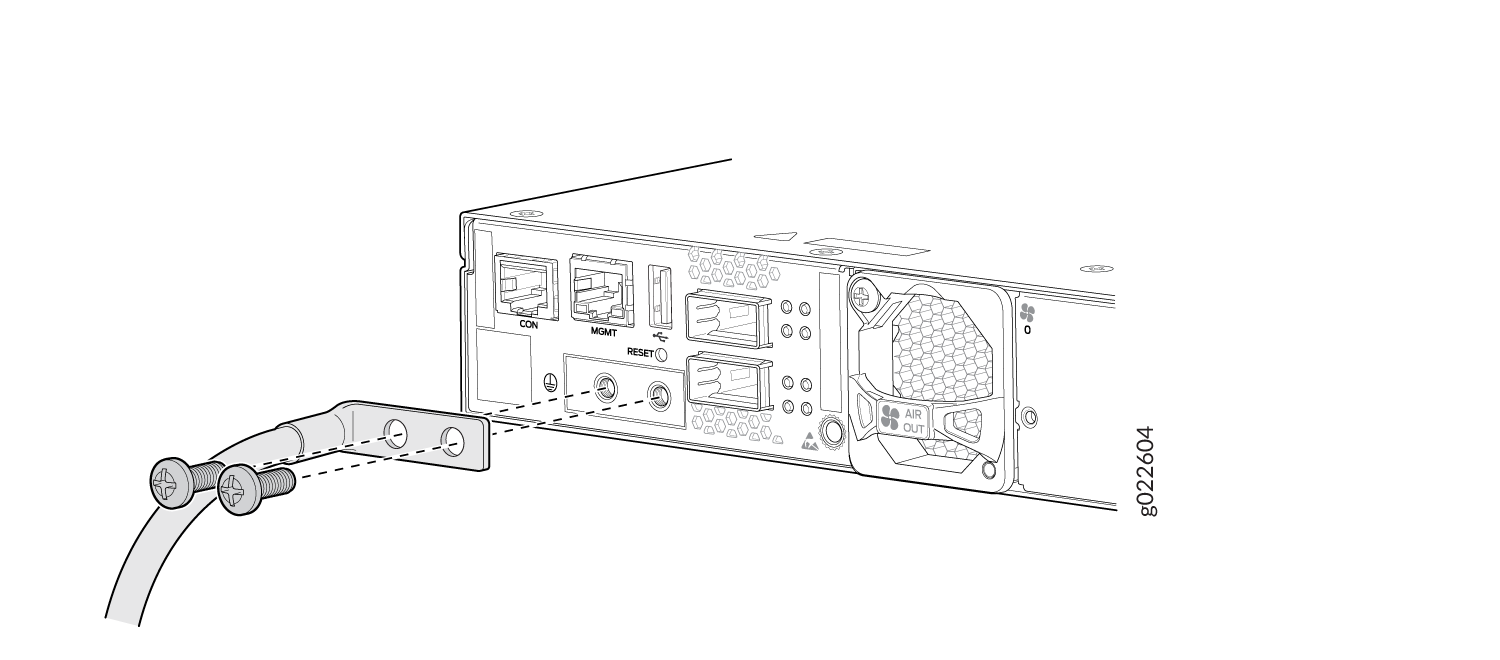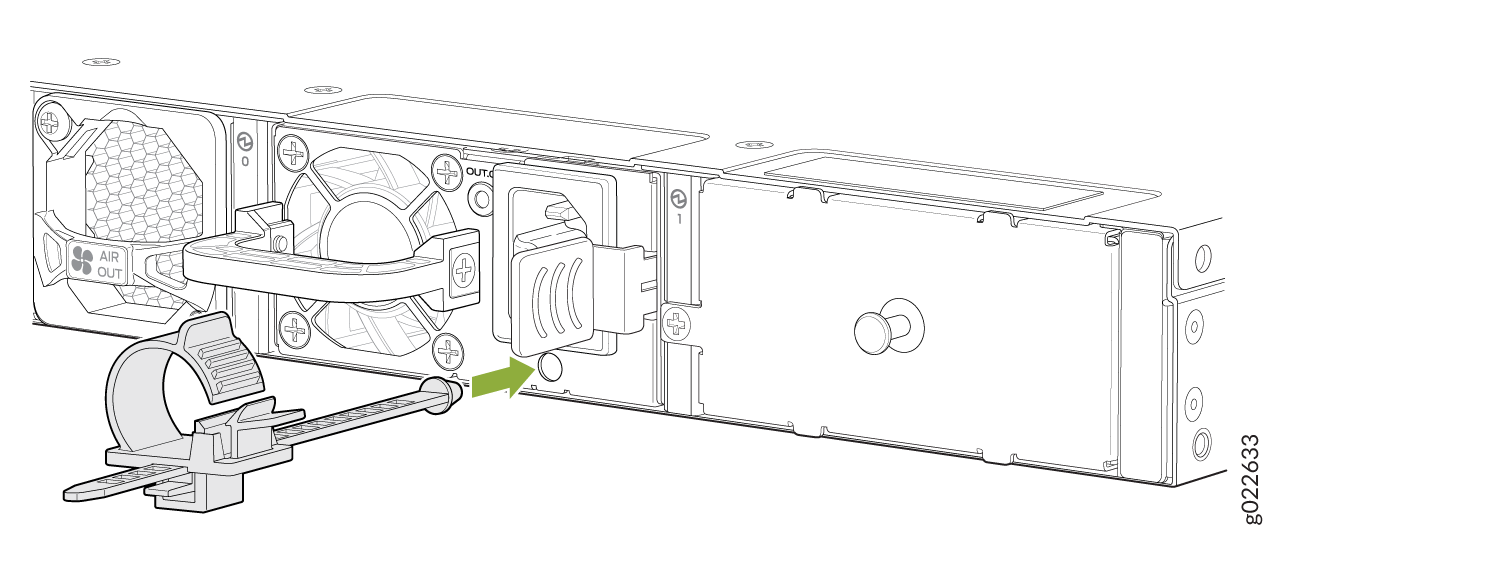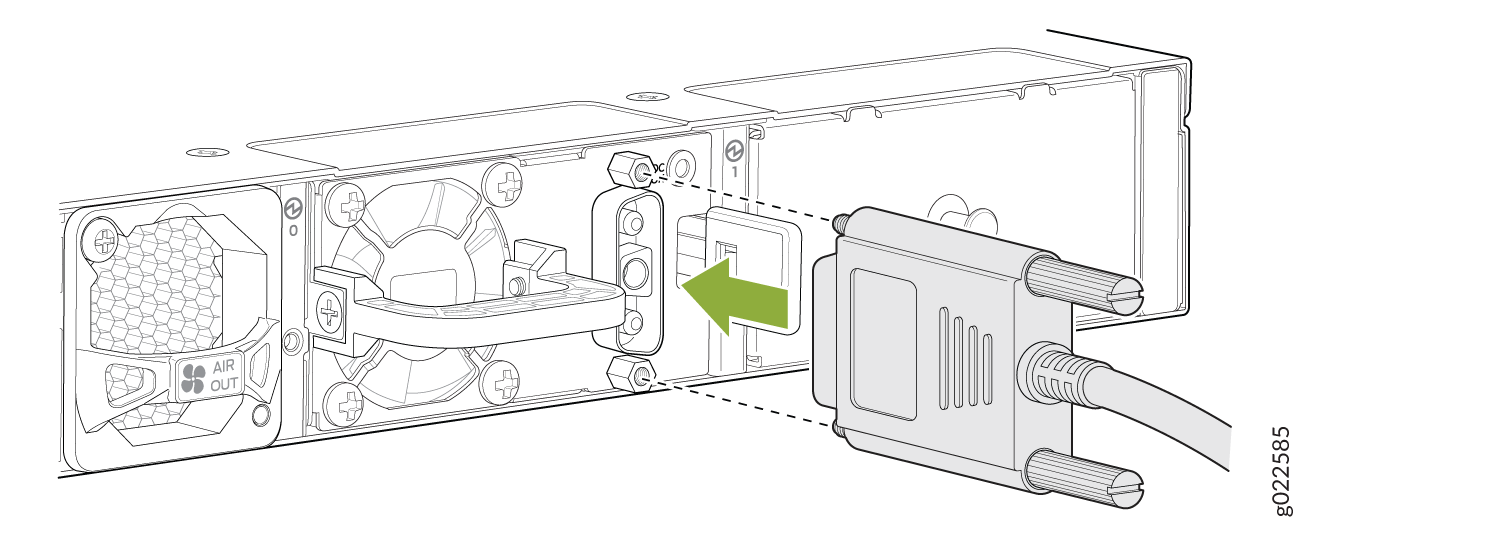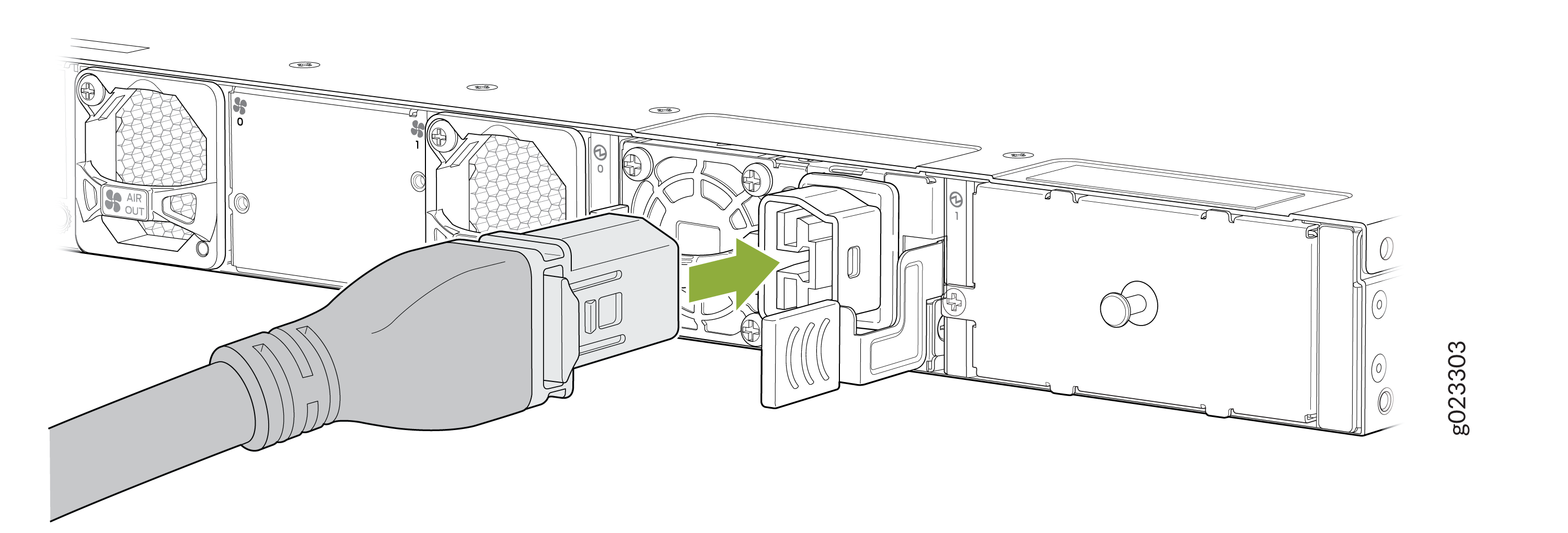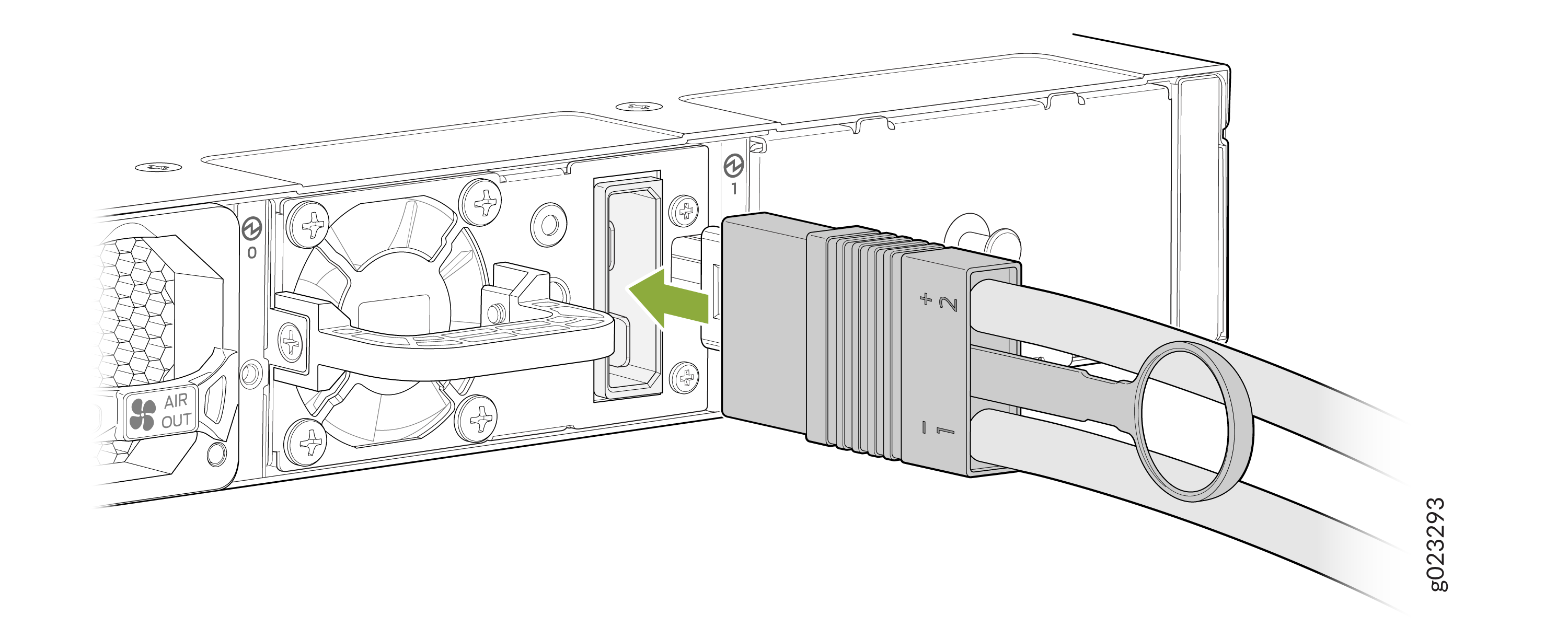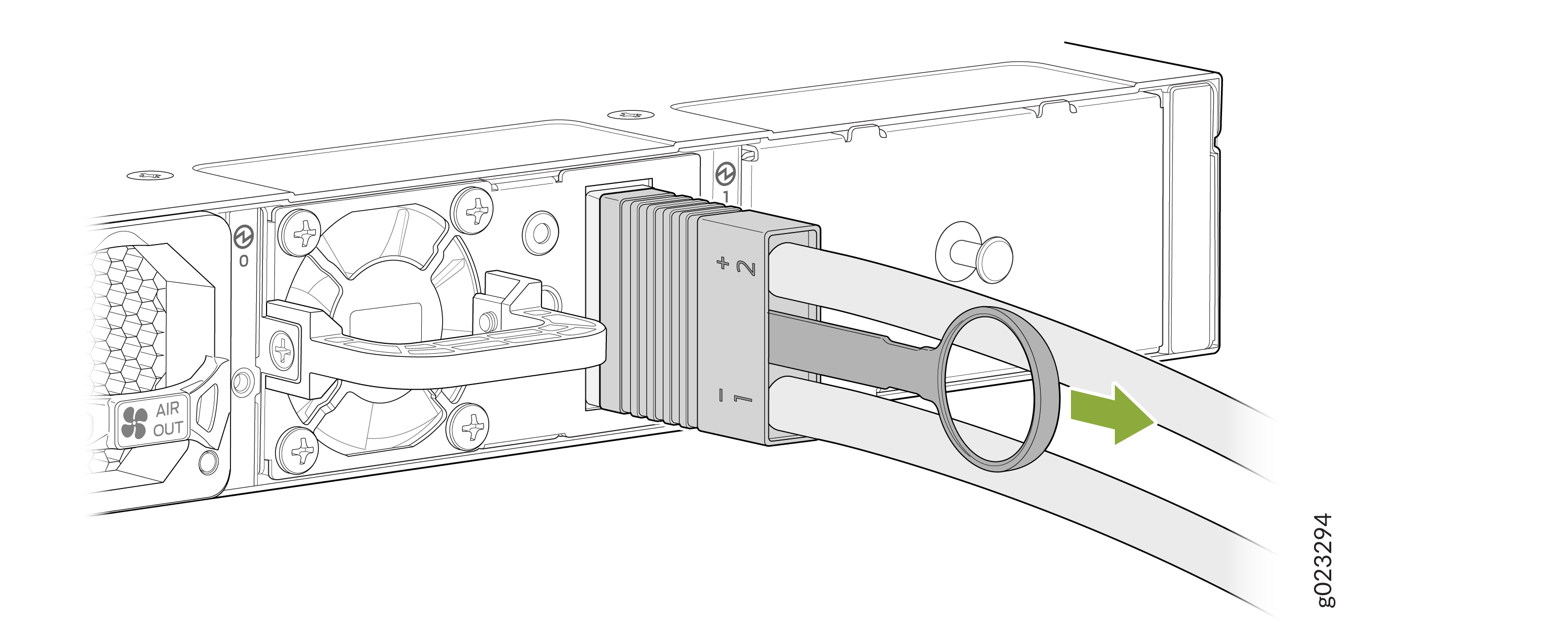Connect the EX4400 to Power
Connect Earth Ground to an EX4400 Switch
To ensure proper operation and to meet electromagnetic interference (EMI) requirements, you must connect the EX4400 switch to earth ground before you connect power to the switch. You must use the protective earthing terminal on the switch chassis to connect the switch to earth ground (see Figure 1).
You must install the EX4400 switch in a restricted-access location and ensure that the chassis is always properly grounded. EX4400 switches have a 2-hole protective grounding terminal on the rear panel of the chassis. Under all circumstances, use this grounding connection to ground the chassis. For AC-powered systems, you must also use the grounding wire in the AC power cord along with the two-hole grounding lug connection. This tested system meets or exceeds all applicable EMC regulatory requirements with the two-hole protective grounding terminal.
Ensure that a licensed electrician has attached the appropriate grounding lug to the grounding cable that you supply. Using a grounding cable with an incorrectly attached lug can damage the switch.
To ground the EX4400 system, you can use either LCD10-10AF-L or LCD8-10AF-L two hole lug to ground the EX4400 switch. Follow these guidelines:
-
Use 14 AWG ( 3.3 mm²) wire or as per local code if you are using LCD10-10AF-L
-
Use 8 AWG (8 mm²) wire or as per local code if you are using LCD8-10AF-L.
-
Use 6 AWG ( 13.3 mm2) wire or as per local code if you are using a LCD6-10AF-L
To ground the EX4400 switch:
Connect AC Power to an EX4400 Switch
Before you connect AC power to the switch:
-
Ensure that you have a power cord appropriate for your geographical location available.
-
Ensure that you have the power cord retainer shipped with the switch.
-
Ensure that you have taken the necessary precautions to prevent electrostatic discharge (ESD) damage (see Prevention of Electrostatic Discharge Damage).
-
Ensure that you have an ESD grounding strap (not provided).
-
Ensure that you have connected the switch chassis to earth ground.
CAUTION:Before you connect power to the switch, a licensed electrician must attach a cable lug to the grounding cable that you supply. A cable with an incorrectly attached lug can damage the switch (for example, by causing a short circuit).
To meet electromagnetic interference (EMI) requirements and to ensure proper operation, you must connect the chassis to earth ground before you connect it to power (see Connect Earth Ground to an EX4400 Switch).
-
Ensure that you provide an external certified circuit breaker (2-pole circuit breaker based on your device current rating) rated minimum 13 A, 16 A, or 20 A in the building installation or as per local electrical code.
We ship the EX4400 switches with one power supply preinstalled on the rear panel. Each power supply is a hot-removable and hot-insertable field-replaceable unit (FRU) when the second power supply is installed and running: You can remove and replace either one of them without powering off the switch or disrupting switch functions.
To connect power to an EX4400 switch with an AC power supply:
Connect DC Power to an EX4400 Switch
Before you connect DC power to the switch:
-
Ensure that you have taken the necessary precautions to prevent electrostatic discharge (ESD) damage (see Prevention of Electrostatic Discharge Damage).
-
Ensure that you have connected the switch chassis to earth ground.
CAUTION:Before you connect power to the switch, a licensed electrician must attach a cable lug to the grounding cable that you supply. A cable with an incorrectly attached lug can damage the switch (for example, by causing a short circuit).
To meet electromagnetic interference (EMI) requirements and to ensure proper operation, you must connect the chassis to earth ground before you connect it to power (see Connect Earth Ground to an EX4400 Switch).
Ensure that you have the following parts and tools available:
-
DC power source cord with a connector (CBL-JNP-PWR-DSUB)—provided
-
Number 2 Phillips (+) screwdriver—not provided
-
An ESD grounding strap—not provided
We ship the EX4400 switches with one power supply preinstalled on the rear panel. You can install up to two power supplies in the switch. You must order the second power supply and a power source cord separately. Each power supply is a hot-removable and hot-insertable field-replaceable unit (FRU) when the second power supply is installed and running. You can remove and replace either one of the power supplies without powering off the switch or disrupting switch functions.
You must connect the battery returns of the DC power supply to frame ground.
To connect power to an EX4400 switch with a DC power supply:
Connect Power to an EX4400-48F-S Switch Using the 550-W VDC PSU
Before you connect power to the switch:
-
Ensure that you have taken the necessary precautions to prevent electrostatic discharge (ESD) damage (see Prevention of Electrostatic Discharge Damage).
-
Ensure that you have connected the switch chassis to earth ground.
CAUTION:Before you connect power to the switch, a licensed electrician must attach a cable lug to the grounding cable that you supply. A cable with an incorrectly attached lug can damage the switch (for example, by causing a short circuit).
To meet electromagnetic interference (EMI) requirements and to ensure proper operation, you must connect the chassis to earth ground before you connect it to power (see Connect Earth Ground to an EX4400 Switch).
Ensure that you have the following parts and tools available:
-
Power Cord (SAF D-Grid) with a connector—provided
-
An ESD grounding strap—not provided
You can install up to two power supplies in the switch. Each power supply is a hot-removable and hot-insertable field-replaceable unit (FRU) when the other power supply is installed and running. You can remove and replace either one of the power supplies without powering off the switch or disrupting switch functions.
You must connect the battery returns of the DC power supply to frame ground.
To connect power to an EX4400-48F-S switch with a VDC power supply:
Connect 2000-W DC Power to an EX4400 Switch
You can connect the EX4400-24P, EX4400-24MP, EX4400-48P, EX4400-48MP, EX4400-48XP, and EX4400-48MXP to the 2000-W DC power supply. Before you connect 2000-W DC power to the switch:
-
Ensure that you have taken the necessary precautions to prevent electrostatic discharge (ESD) damage (see Prevention of Electrostatic Discharge Damage).
-
Ensure that you have connected the switch chassis to earth ground.
CAUTION:Before you connect power to the switch, a licensed electrician must attach a cable lug to the grounding cable that you supply. A cable with an incorrectly attached lug can damage the switch (for example, by causing a short circuit).
To meet electromagnetic interference (EMI) requirements and to ensure proper operation, you must connect the chassis to earth ground before you connect it to power (see Connect Earth Ground to an EX4400 Switch).
Ensure that you have the following parts and tools available:
-
DC power source cord with a connector (CBL-PWR-2K-DSUB4)—provided
-
Number 2 Phillips (+) screwdriver—not provided
-
An ESD grounding strap—not provided
You can install up to two power supplies in the switch. Each power supply is a hot-removable and hot-insertable field-replaceable unit (FRU) when the second power supply is installed and running. You can remove and replace either one of the power supplies without powering off the switch or disrupting switch functions.
You must connect the battery returns of the DC power supply to frame ground.
To connect power to an EX4400 switch with a 2000-W DC power supply:

